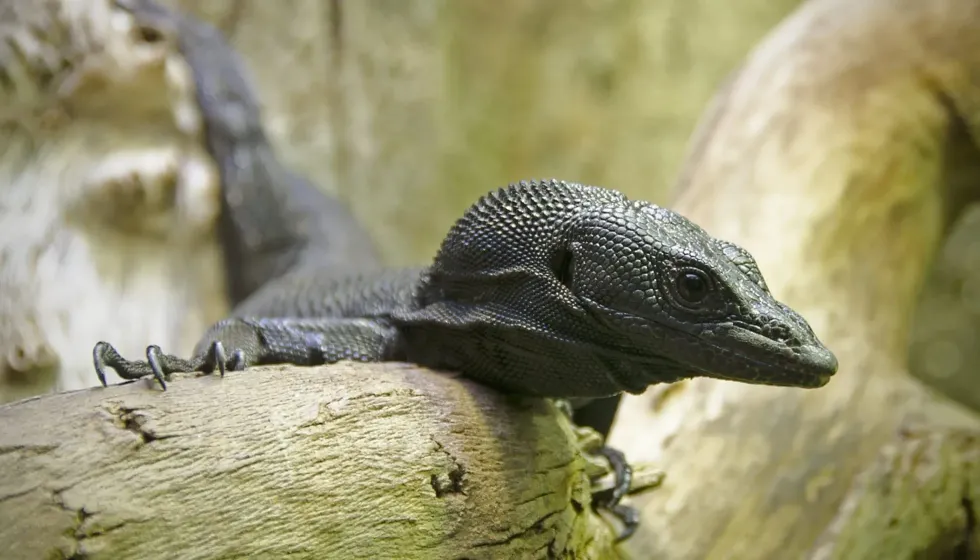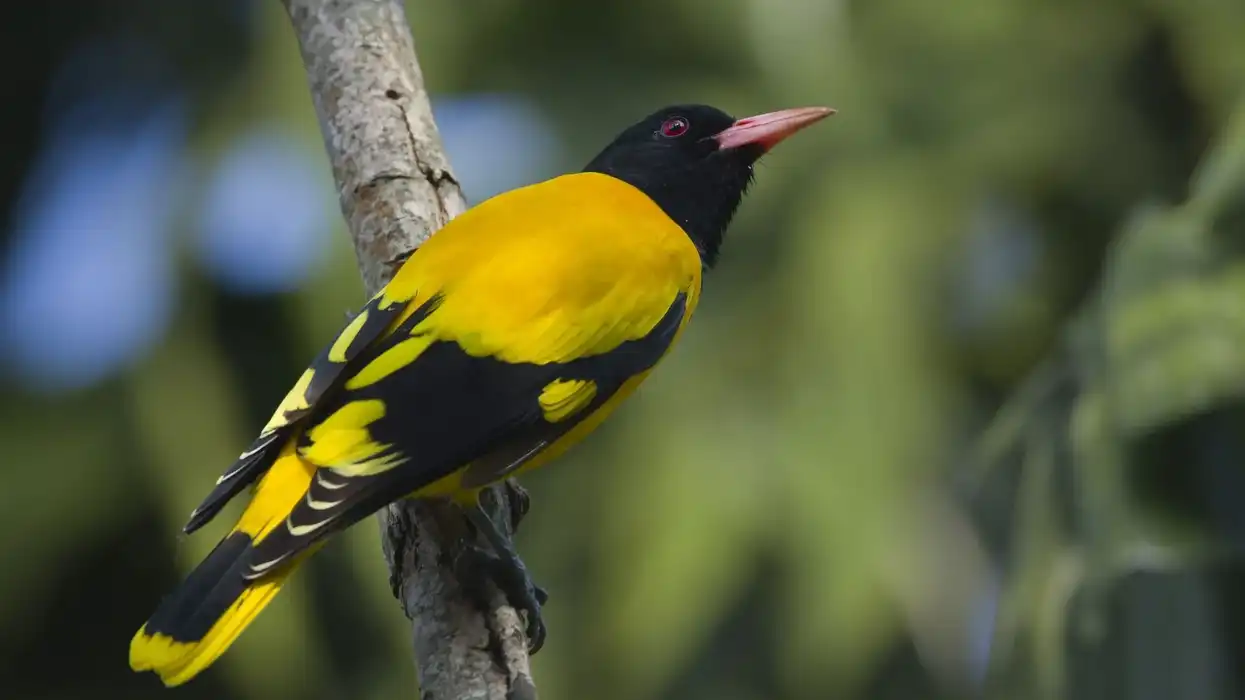Black tree monitors, or Varanus beccarii, are a type of lizard. They need the ideal humidity and substrate surface temperature in the wild and captive conditions in a zoo to thrive and breed well. Sun basking can help to keep a substrate surface temperature under captive conditions, and basking can even mimic their natural habitat.
This species is endemic to the Indonesian islands, and black tree monitor studies indicate that their conservation status is Data Deficient.
The main difference between the black tree monitor and the green tree monitor is that the color of green tree monitors doesn't change much when they grow up, nor are they nervous or shy, while the black tree monitors are shy and nervous. They turn completely black when they grow up with no other pigmentation on their skin.
Both are slightly different regarding body parts and habits.
To find out more interesting facts and information about other animals, you can also check out Texas horned lizard facts and lava lizard facts for more enriching and mind-blowing facts and guides.
Black Tree Monitor Interesting Facts
What type of animal is a black tree monitor?
Black tree monitors lizard is closely related to the green tree monitor lizards. The black tree monitor (Varanus beccari) is natively found in the Aru Islands of Indonesia, New Guinea.
The monitor (Varanus beccarii) is completely black in color once it becomes an adult. They can also be related to the black Nile tree monitor lizard. Black tree monitor phylum is supposedly Chordata and includes arboreal lizards.
What class of animal does a black tree monitor belong to?
Black tree monitor lizards belong to the class Reptilia, including other lizards, monitor lizards, and other creatures like the black tree monitor.
How many black tree monitors are there in the world?
There are many black tree monitors in the Aru Islands and under captive conditions as the black tree monitor care routines are not that difficult to maintain. They are mainly found in Indonesia. They can be seen in zoos and other zoological spaces, as well.
Where does a black tree monitor live?
They are found mainly in humid forests, mangrove swamps, lowland rainforests, cocoa plantations, and palm forests of the Aru Islands of Indonesia.
What is a black tree monitor's habitat?
Their habitat basically includes trees and vines in humid forests, mangrove swamps, lowland rainforests, cocoa plantations, palm forests under wild conditions. They are well adapted to the wild and can easily climb trees like monkeys. They are also well adapted to humidity, and they can stay on the canopy of trees.
In captive conditions, the full-grown black tree monitor lizard (adult black tree monitor) can be kept under an ideal temperature setting like a simulated wild setting with an accurate humidity level for them to thrive. Under captivity, they need a large enclosure when they are adults.
The enclosure should not be less than 5 ft (1.5 m) wide, 2 ft (0.6 m) deep, and 4 ft (1.2 m) high and include horizontal branches and logs. The black tree monitor's enclosure in captivity should mimic the wild's day and night cycle and spaces to regulate their body temperature.
You can use UVB or basking bulbs to regulate their temperature.
Black tree monitor taming, black tree monitor feeding, and breeding patterns are also important in captivity. They consist of a larger part of the lizard pet trade.
Who do black tree monitors live with?
They are generally shy and not that social and like to hide under shades and plants in the wild and in captivity like the zoo or a pet house. It is recommended to keep them alone or in opposite-sex pairs as keeping only males can make them fight amongst themselves.
How long does a black tree monitor live?
The black tree monitor's lifespan can range from 10-15 years both in wild habitat and captive habitat in a zoo or as a pet.
How do they reproduce?
With the scientific name Varanus beccarii, these species are known to lay their eggs in arboreal termite nests. Little is known about their reproductive pattern in the wild, but in a zoo and under captive conditions as pets, their breeding can be done.
The copulation period can last for two hours. The gestation period is 164-165 days.
Force-feeding might be required for two weeks with a proper diet of insects, small animals, and rodents for the reptile to grow properly. The new reptile has shades of green and yellow on their body that become black in 12 weeks when they become adults.
What is their conservation status?
They are under the list of Data Deficient animal species. Still, their population could be of concern in a few years as the adult black tree monitors are losing their natural habitat to deforestation.
Black Tree Monitor Fun Facts
What do black tree monitors look like?

Reptiles from this species are quite small in size as compared to other big monitors. When they hatch from their eggs, they have a greenish shade yellow tint, but as they grow up, they are pitch black, and that is why they got their name as black tree monitors.
Their prehensile tail is particularly long and about two-thirds of their total length. Their prehensile tail can act as an extra limb for them, and it is really strong.
Males are generally bigger than females with a triangular-shaped tail, while females have a round-shaped tail. They are extremely slender and have long narrow necks and heads. Their jaws have powerful flattened teeth and curve slightly towards the inside.
They have big legs with five clawed toes. The scales on their body have a granular pattern.
How cute are they?
They are not considered to be that cute but are found beautiful by many exotic pet owners all over the world. People keep them as pets. Black tree monitor temperament is good, and they generally hide when encountered with other animals and are quite shy and peaceful.
How do they communicate?
Like other species of monitors, black tree monitors also communicate through smell, behavioral patterns, visuals like body posture, audio-like sound patterns, and other such ways. During the mating season, they often compete with one another and jump from one tree to another to prove their agility and strength to females.
The males often chase the females during the breeding season. Under captive conditions, they are considered smart pets, and they can recognize their owners' voices if tamed properly. They have an excellent sense of temperature and humidity levels.
How big is a black tree monitor?
Black tree monitors are generally smaller than other big monitors. Their size can range from 35-47 in (90-120 cm), and they have a tail that is two times bigger than their body. Newborns are 8 in (20 cm) in length and slowly become adults.
How fast can a black tree monitor run?
They can run really fast as they have great speed and agility, allowing them to climb trees and jump on trees at a really quick pace. They are known to run away and hide real quick if encountered with any danger in natural conditions. Their exact speed is unknown.
How much does a black tree monitor weigh?
Though not much information is available regarding their weight, if estimated as per sources, they can weigh between 0.33-0.55 lb (150-250 g) when they become fully grown adults. When they are small and have just hatched, they weigh around 0.2-0.35 oz (8-10 g).
What are the male and female names of the species?
There is no such specific name for a male or female black tree monitor.
What would you call a baby black tree monitor?
There is no specific name for the baby. You could refer to them as hatchlings in general.
What do they eat?
They are mostly carnivores and insectivores. Black tree monitor diet usually consists of small insects, mammals, small reptiles, crabs, bird hatchlings, small invertebrates, smaller lizards, shrews, scorpions, rodents, eggs, small birds, and frogs.
Under captivity, their diet can comprise a lot of things like a mixture of high protein sources, live animals, crickets, Dubia roaches, mealworms, tapeworms, and grasshoppers. Their diet can also comprise protein sources like fish, fish eggs, chicks eggs, and ducklings. They should be regularly fed as food is important for breeding and other activities.
They require food that is almost three-fourth of their body weight. Initially, they might refuse to eat, but they should be compelled to eat.
Are they dangerous?
No, they are quite shy and run away or hide if they sense any danger; thus, they are not dangerous. If irritated, they can scratch and bite, and like the other monitor types, their bite can also be infectious, so you should be careful while carrying them.
Would they make a good pet?
Yes, they make a great pet if kept under perfect conditions with ideal humidity conditions. They are really smart and intelligent. They have excellent motor coordination and problem-solving abilities.
Did you know...
Did you know that the tail of black tree monitors is really big? It is almost two-third of its own body size because they need a strong long tail to keep their balance when climbing trees and when moving and jumping fast between trees.
Their tail acts as an extra limb and provides them stability on branches while running and climbing or while catching prey on the canopy of the trees.
How are black tree monitors different from other monitors?
Black tree monitors, unlike other monitors, do not use their tails as weapons. They are quite shy and run away easily. They are nervous animals and hide easily.
Are black tree monitors sociable?
No, they are nervous animals and usually hide amidst trees when humans are present. They like to live alone and mostly hide or run away from other animals.
Here at Kidadl, we have carefully created lots of interesting family-friendly animal facts for everyone to discover! Learn more about some other reptiles from our blue-tongued skink facts and map turtle facts pages.
You can even occupy yourself at home by coloring in one of our free printable black tree monitor coloring pages.










